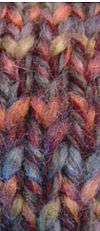Welting (knitting)

In knitting, welting is the horizontal analog of ribbing; that is, one or more horizontal rows of knit stitches alternating with one or more rows of purl stitches.
The simplest welting is garter stitch, in which knit rows alternate with purl rows. If the fabric is produced "in the round", the effect is simply produced by knitting one row, then purling the next. If the fabric is being knit back-and-forth, turned after every row, the effect is produced even more simply by knitting each row—first from the right side, then from the wrong side.
Similar to ribbing, a welting pattern can be specified by the number of knit rows followed by the number of purl rows, e.g., 1x1 welting is garter stitch. Many complicated patterns of purely horizontal stripes are possible, which can be worked in yarns of different color, thickness and texture for added visual interest, e.g., wide stripes of red chenille alternating with narrow stripes of black worsted wool.
Welts can be decorated with nearly any motif used for a plain knitted fabric, e.g., bobbles, lace, and various colors. However, cables cannot be made horizontally; if desired, cables must be worked as a separate piece.
A tuck can be created when a previous row is knit together, stitch by stitch, with the present row, forming a round ridge that projects outwards towards the right side. Used as a decorative detail.
References
- (2002) Vogue Knitting: The Ultimate Knitting Book, updated ed., Sixth and Spring Books. ISBN 1-931543-16-X
- (1979) Reader's Digest Complete Guide to Needlework, Reader's Digest Association. ISBN 0-89577-059-8
- Thomas M. (1972) Mary Thomas' Book of Knitting Patterns, Dover. ISBN 0-486-22818-5
- June Hemmons Hiatt (1988) The Principles of Knitting, Simon and Schuster, pp. 20–21, 211-216, 241-242. ISBN 0-671-55233-3
